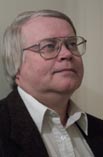|
Leonid MAC |
| home |
| View the shower |
| Mission Brief |
| Science Update |
| Media Brief |
| links |
 Dr. Robert L. Hawkes,
Dr. Robert L. Hawkes, Mount Allison University, Canada. 
Last updated: October 2002
Brief Biographical Information: Dr. Hawkes has a Ph.D. in Physics, and a Bachelor's degree in Education. He has taught undergraduate physics courses at Mount Allison since 1980, and has consistently been recognized as one of the most capable and effective professors at the University. He is equally popular with students in large service courses (Astronomy, Introductory Physics) and with students taking courses for Majors or Honours degrees in Physics. Dr. Hawkes is actively involved in teaching committes at the university, and nationally. His teaching skills and talents have been recognized with local awwrds (the Herbert and Leota Tucker Award for Excellence in Teaching (1988), Paul Par˙ý Award of Excellence (1995,1997), Paul Par˙ý Medal of Excellence (1998)), regional awards (APICS/Power Utilities Atlantic Science Teacher Award (1991-92)), national awards (3M Teaching Fellow Award, 1988), and recipient of the 2000 Medal for Excellence in Teaching Physics awarded by the Canadian Association of Physicists (CAP). Research Interests: Dr. Hawkes is an active meteor astronomer at Mount Allison University, specializing on TV imaging techniques and their application to meteor studies. He is a leading member of the Canadian METEORITES AND IMPACTS ADVISORY COMMITTEE and the International Astronomical Union Commission on Interplanetary Dust. Research on Leonid MAC: Light Curves, Satellite Impact Hazard issue In an observing effort executed by Ian Murray,and in collaboration with Martin Beech of Regina University, we have used dual coaxial microchannel plate image intensified monochrome CCD detectors run at standard NTSC frame rates (30 fps) to study the Leonid meteor shower during the 1998 and 1999 Leonid MAC missions. In the 1999 Leonid MAC, we discovered that the lightcurves tended to differ from those in the 1998 campaign, suggesting that meteoroids fragmented differently. More about this published work can be found here. In future missions, we will continue to study the morphological changes as a function of different positions in the comet dust trails and as a function of age since ejection.
|

